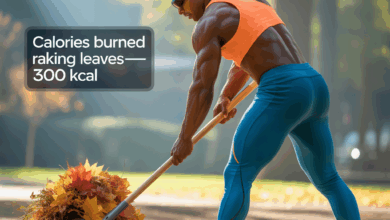How Many Calories Does Sneezing Burn? The Small Truth About Tiny Movements

Have you ever joked that your allergy season doubled as a workout because you were sneezing all day? Picture counting sneezes like reps on a fitness tracker — could those sudden bursts of energy actually help burn calories? Before you start adding “sneeze sets” to your routine, let’s unpack the real answer: how many calories does sneezing burn, and what actually matters for weight control.
Quick answer: how many calories does sneezing burn?
Short version: almost none. A single sneeze burns only a tiny fraction of a calorie — typically well under 1 kilocalorie (kcal). Estimates vary because there’s no large-scale study measuring energy expenditure per sneeze, but most physiological reasoning and small calculations place one sneeze at roughly 0.05–0.3 kcal. That means even a long sneezing fit of 20 sneezes might only burn a few calories — far less than a single minute of brisk walking.
Why sneezing burns so few calories
Sneezing is a brief, explosive reflex. The muscles involved (diaphragm, chest wall, abdominal and throat muscles) contract hard but for a split second. Energy expenditure depends on three things:
- Duration: Sneezes last less than a second.
- Muscle mass involved: Small to moderate muscle groups — not the large leg or back muscles that burn more energy.
- Metabolic cost: The body’s oxygen use and heart rate only rise briefly.
Because of those factors, the metabolic equivalent of a sneeze is tiny compared to deliberate exercise. In plain terms: it’s a reflex, not a workout.
Real-world perspective
Compare a sneeze to other small movements: fidgeting, standing up, or climbing a flight of stairs. Those activities involve sustained or repeated muscle activity and therefore burn more calories. Sneezes are flashy but fleeting.
Small movements add up: NEAT and everyday calorie burn
That said, don’t dismiss the value of tiny movements entirely. NEAT — non-exercise activity thermogenesis — is the energy you spend on all activities outside formal workouts (walking to the bus, fidgeting, house chores). NEAT can make a meaningful difference in daily calorie burn when accumulated.
So while sneezing itself contributes almost nothing, increasing NEAT through simple, sustained behaviors will:
- Boost total daily energy expenditure
- Help with weight maintenance and fat loss when paired with diet
- Improve circulation and posture
Practical tips: more effective ways to burn calories than sneezing
If your goal is to burn more calories and improve fitness, use strategies that rely on sustained effort and larger muscle groups. Here are practical ideas that beat counting sneezes:
Workout variations (brief, effective options)
- High-Intensity Interval Training (HIIT): 20–30 minutes of alternating sprints and recovery boosts calorie burn and metabolic rate.
- Strength training: Compound moves (squats, deadlifts, rows) build muscle, which raises resting metabolic rate.
- Walking breaks: 10–15 minute brisk walks every few hours increase NEAT and break sedentary time.
Daily lifestyle adjustments
- Stand or walk during phone calls.
- Use a standing desk or take micro-breaks to stretch and move.
- Choose stairs over elevators whenever possible.
Nutrition and recovery: why they matter more than tiny calorie burns
Even with a high NEAT and regular workouts, nutrition drives results. Balanced meals with lean protein, whole grains, healthy fats, and vegetables support performance and recovery. Staying hydrated, sleeping well, and managing stress are also essential — they influence hormones that regulate appetite and metabolism.
For structured guidance, check out our nutrition guides and combine them with effective movement plans from our workout routines.
When a sneeze might matter (fun, but marginal)
There are a few niche scenarios where sneezing-related calorie burn is interesting:
- Very large sneezing fits (e.g., persistent allergy attacks) repeated over hours could add up to a measurable but still small number of calories.
- If you count every tiny movement for a novelty step challenge, sneezes will show up in some fitness trackers as motion, but they won’t significantly influence weight loss.
- Using sneezes as a reminder to move — e.g., after a sneeze, stand and stretch — is a clever habit hack to increase daily activity.
Frequently Asked Questions
No. A single sneeze burns a tiny fraction of a calorie. Weight loss requires a consistent calorie deficit achieved through diet and sustained activity, not involuntary reflexes.
Some trackers may register strong movements as activity, but manufacturers design algorithms to filter out very short movements. Relying on sneezes to boost metrics isn’t effective or recommended.
Focus on NEAT: take short walks, use the stairs, do bodyweight circuits, and stand more. Small, repeated actions add up; combine them with resistance training and sensible nutrition for best results. For ideas, check our wellness tips.
Conclusion — the bottom line on “how many calories does sneezing burn”
Sneezing is dramatic but metabolically insignificant. The answer to “how many calories does sneezing burn” is: practically none — usually well under 1 kcal per sneeze. If you want meaningful calorie burn and better fitness, prioritize structured workouts, increase NEAT, and dial in nutrition and recovery.
Ready to turn tiny moments into real progress? Start with one small habit today: replace one sedentary hour with two 10-minute walks, add one strength session this week, and use our workout routines and nutrition guides to build a plan that actually moves the needle. Share your progress or questions below — I’d love to hear how you turn everyday movement into long-term gains!





